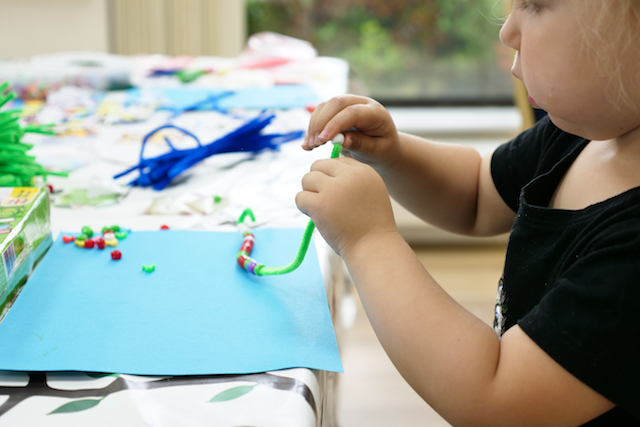Threading beads, also referred to as beading, or stringing beads, is a great activity for little ones and one that has numerous developmental benefits. Threading can be a challenging activity that takes a while for a child to master and is very much dependent on their maturity and fine motor development – something that we’re constantly working on in our classes – but we believe it’s never too early to try and get those fine motor skills going so it’s something we try and do every term, in some form or another, because of it’s many great benefits as outlined below!
Fine Motor Control:
Threading is an excellent way to strengthen the finger muscles and learn to control the fingers as they work together, and crucially the relationship between the thumb and forefinger – the ‘pincer’ that we are always talking about in classes!
Bilateral Coordination:
Bilateral coordination is about using both sides of the body to perform various tasks such as dressing, cutting a piece of paper and walking.
There are movements that are symmetrical (such as clapping hands), alternating (such as running) and then there are movements that require a dominant and a supporting hand.
When threading beads, a child must try to hold the bead with one hand while controlling the string/pipe-cleaner with the other.
Colour Recognition:
Beading is a great way to practise colour recognition.
There are many ways that this can be done, for instance, whilst beading together why not ask ask your little one to pass you the blue bead, or to make a pattern with red and yellow beads, or tell you what colour bead he/she would like to thread next. All a great way of reinforcing our colours.
Visual Perception:
Visual perception is when the brain makes sense of what the eyes see.
It is an important pre-reading skill and children must develop their letter recognition through play first – by being exposed to lines, patterns and shapes, which they will later see in letters.
Hand-Eye Coordination:
Threading beads is good practice for building hand-eye coordination, an important aspect of physical development.
Do you want your child to excel at sports one day? Then spend lots of time doing movement activities, but also lots of time doing intricate activities such as playing with pegboards, and beading to let the eyes and hands work together.
Do you want them to be a Surgeon? Artist? Musician? Then fine motor skills are something to get them practicing early!
Early Maths Skills:
Playing with toys such as blocks and beads teaches children about the concept of number and amount, as well as one-to-one correspondence.
And as briefly mentioned above, you can also introduce patterning activities to your little one which is an important early maths concept.
Concentration and Perseverance:
Fine motor activities usually require a child to sit for lengthy periods of time, which in turn builds their attention span, (one of the many benefits of our classes) and helps them to focus.
The act of trying something as intricate as threading a string through a tiny hole will teach a child not only how to sit still and focus, but also how to persevere and try again if he/she fails.
We never cease to be amazed by the focus that is shown by the little ones in our classes when it’s Beading week!
Language:
When children are engaging in this (or any) activity they are learning the vocabulary around what they are doing.
When your child is threading, be sure to talk to them about what they are doing. ie, Shall we thread these beads onto this pipe cleaner? Could we make a bracelet? Can you repeat the colour pattern? Are the holes very small? etc etc.
All of these benefits are things we strive to achieve, to a greater or lesser degree, every week in our classes – and all of these are things that can be reinforced and practiced at home – with beading in particular an activity that really does capture the focus and attention of many young children.
